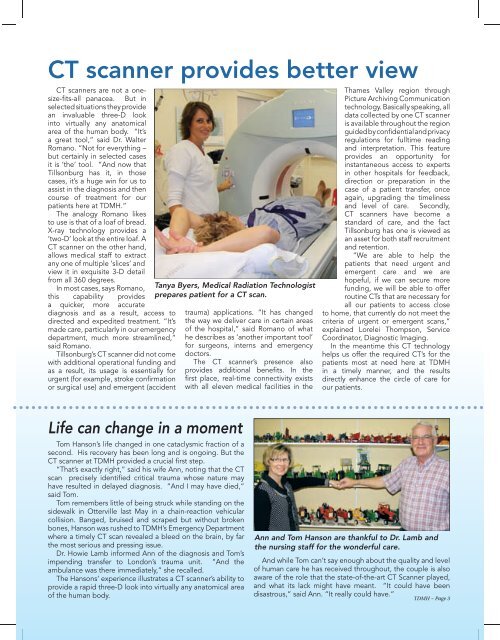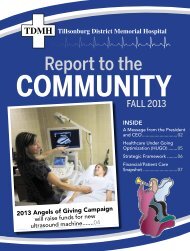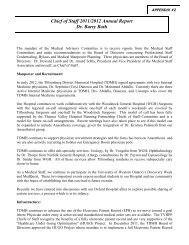Working together to build a Healthy Community
Ãn - Tillsonburg District Memorial Hospital
Ãn - Tillsonburg District Memorial Hospital
- No tags were found...
You also want an ePaper? Increase the reach of your titles
YUMPU automatically turns print PDFs into web optimized ePapers that Google loves.
CT scanner provides better view<br />
CT scanners are not a onesize-fits-all<br />
panacea. But in<br />
selected situations they provide<br />
an invaluable three-D look<br />
in<strong>to</strong> virtually any ana<strong>to</strong>mical<br />
area of the human body. “It’s<br />
a great <strong>to</strong>ol,” said Dr. Walter<br />
Romano. “Not for everything –<br />
but certainly in selected cases<br />
it is ‘the’ <strong>to</strong>ol. “And now that<br />
Tillsonburg has it, in those<br />
cases, it’s a huge win for us <strong>to</strong><br />
assist in the diagnosis and then<br />
course of treatment for our<br />
patients here at TDMH.”<br />
The analogy Romano likes<br />
<strong>to</strong> use is that of a loaf of bread.<br />
X-ray technology provides a<br />
‘two-D’ look at the entire loaf. A<br />
CT scanner on the other hand,<br />
allows medical staff <strong>to</strong> extract<br />
any one of multiple ‘slices’ and<br />
view it in exquisite 3-D detail<br />
from all 360 degrees.<br />
In most cases, says Romano,<br />
this capability provides<br />
a quicker, more accurate<br />
diagnosis and as a result, access <strong>to</strong><br />
directed and expedited treatment. “It’s<br />
made care, particularly in our emergency<br />
department, much more streamlined,”<br />
said Romano.<br />
Tillsonburg’s CT scanner did not come<br />
with additional operational funding and<br />
as a result, its usage is essentially for<br />
urgent (for example, stroke confirmation<br />
or surgical use) and emergent (accident<br />
Tanya Byers, Medical Radiation Technologist<br />
prepares patient for a CT scan.<br />
trauma) applications. “It has changed<br />
the way we deliver care in certain areas<br />
of the hospital,” said Romano of what<br />
he describes as ‘another important <strong>to</strong>ol’<br />
for surgeons, interns and emergency<br />
doc<strong>to</strong>rs.<br />
The CT scanner’s presence also<br />
provides additional benefits. In the<br />
first place, real-time connectivity exists<br />
with all eleven medical facilities in the<br />
Thames Valley region through<br />
Picture Archiving Communication<br />
technology. Basically speaking, all<br />
data collected by one CT scanner<br />
is available throughout the region<br />
guided by confidential and privacy<br />
regulations for fulltime reading<br />
and interpretation. This feature<br />
provides an opportunity for<br />
instantaneous access <strong>to</strong> experts<br />
in other hospitals for feedback,<br />
direction or preparation in the<br />
case of a patient transfer, once<br />
again, upgrading the timeliness<br />
and level of care. Secondly,<br />
CT scanners have become a<br />
standard of care, and the fact<br />
Tillsonburg has one is viewed as<br />
an asset for both staff recruitment<br />
and retention.<br />
“We are able <strong>to</strong> help the<br />
patients that need urgent and<br />
emergent care and we are<br />
hopeful, if we can secure more<br />
funding, we will be able <strong>to</strong> offer<br />
routine CTs that are necessary for<br />
all our patients <strong>to</strong> access close<br />
<strong>to</strong> home, that currently do not meet the<br />
criteria of urgent or emergent scans,”<br />
explained Lorelei Thompson, Service<br />
Coordina<strong>to</strong>r, Diagnostic Imaging.<br />
In the meantime this CT technology<br />
helps us offer the required CT’s for the<br />
patients most at need here at TDMH<br />
in a timely manner, and the results<br />
directly enhance the circle of care for<br />
our patients.<br />
Life can change in a moment<br />
Tom Hanson’s life changed in one cataclysmic fraction of a<br />
second. His recovery has been long and is ongoing. But the<br />
CT scanner at TDMH provided a crucial first step.<br />
“That’s exactly right,” said his wife Ann, noting that the CT<br />
scan precisely identified critical trauma whose nature may<br />
have resulted in delayed diagnosis. “And I may have died,”<br />
said Tom.<br />
Tom remembers little of being struck while standing on the<br />
sidewalk in Otterville last May in a chain-reaction vehicular<br />
collision. Banged, bruised and scraped but without broken<br />
bones, Hanson was rushed <strong>to</strong> TDMH’s Emergency Department<br />
where a timely CT scan revealed a bleed on the brain, by far<br />
the most serious and pressing issue.<br />
Dr. Howie Lamb informed Ann of the diagnosis and Tom’s<br />
impending transfer <strong>to</strong> London’s trauma unit. “And the<br />
ambulance was there immediately,” she recalled.<br />
The Hansons’ experience illustrates a CT scanner’s ability <strong>to</strong><br />
provide Page 4 - TDMH a rapid three-D look in<strong>to</strong> virtually any ana<strong>to</strong>mical area<br />
of the human body.<br />
Ann and Tom Hanson are thankful <strong>to</strong> Dr. Lamb and<br />
the nursing staff for the wonderful care.<br />
And while Tom can’t say enough about the quality and level<br />
of human care he has received throughout, the couple is also<br />
aware of the role that the state-of-the-art CT Scanner played,<br />
and what its lack might have meant. “It could have been<br />
disastrous,” said Ann. “It really could have.”<br />
TDMH ~ Page 3




